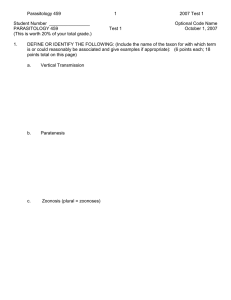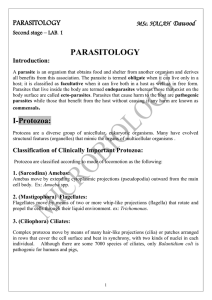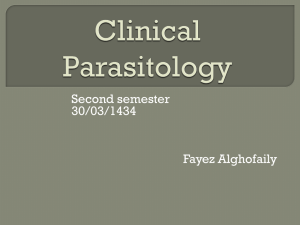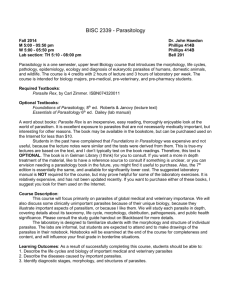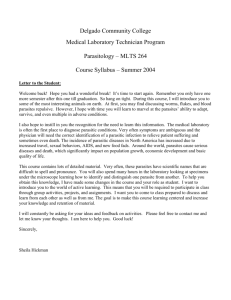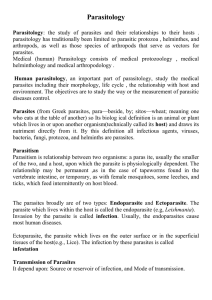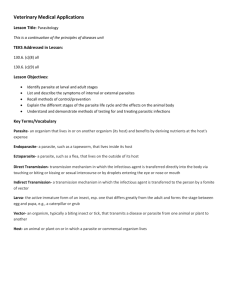محاضره 1
advertisement
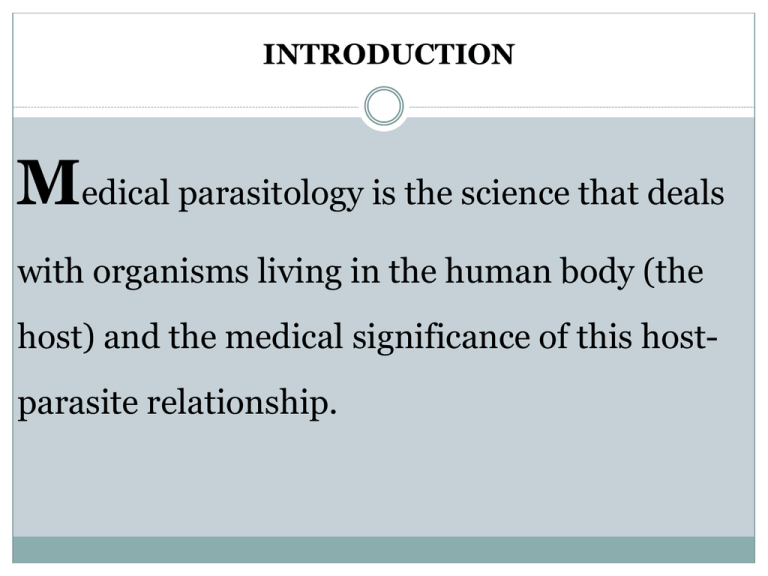
INTRODUCTION Medical parasitology is the science that deals with organisms living in the human body (the host) and the medical significance of this host- parasite relationship. ASSOCIATION BETWEEN PARASITE AND HOST A parasite is a living organism, which takes its nourishment and other needs from a host The host is an organism which supports the parasite. The parasites included in medical parasitology are protozoa,helminthes, and some arthropods. The hosts vary depending on the stages of parasites they harboured. DIFFERENT KINDS OF PARASITES Ectoparasite – a parasitic organism that lives on the outer surface of its host, e.g. lice, ticks, mites etc. Endoparasites – parasites that live inside the body of their host, e.g. Entamoeba histolytica. Obligate Parasite - This parasite is completely dependent on the host during a segment or all of its life cycle, e.g. Plasmodium spp. DIFFERENT KINDS OF PARASITES Facultative parasite – an organism that exhibits both parasitic and non-parasitic modes of living and hence does not absolutely depend on the parasitic way of life, but is capable of adapting to it if placed on a host. e.g. Naegleria fowleri Accidental parasite – when a parasite attacks an unnatural host and survives. e.g. Hymenolepis diminuta (rat tapeworm). Erratic parasite - is one that wanders into an organ in which it is not usually found. e.g. Entamoeba histolytica in the liver or lung of humans Most of the parasites which live in/on the body of the host do not cause disease (non-pathogenic parasites). In Medical parasitology we will focus on most of the disease causing (pathogenic) parasites. However, understanding parasites which do not ordinarily produce disease in healthy (immunocompetent) individuals but do cause illness in individuals with impaired defense mechanism (opportunistic parasites) is becoming of paramount importance because of the increasing prevalence of HIV/AIDS in our world DIFFERENT KINDS OF HOSTS Definitive host – a host that harbors a parasite in the adult stage or where the parasite undergoes a sexual method of reproduction. Intermediate host – harbors the larval stages of the parasite or an asexual cycle of development takes place. In some cases, larval development is completed in two different intermediate hosts, referred to as first and second intermediate hosts. DIFFERENT KINDS OF HOSTS Paratenic host – a host that serves as a temporary refuge and vehicle for reaching an obligatory host, usually the definitive host, i.e. it is not necessary for the completion of the parasites life cycle. Reservoir host – a host that makes the parasite available for the transmission to another host and is usually not affected by the infection. Natural host – a host that is naturally infected with certain species of parasite. Accidental host – a host that is under normal circumstances not infected with the parasite There is a dynamic equilibrium which exists in the interaction of organisms. Any organism that spends a portion or all of its life cycle intimately associated with another organism of a different species is considered as Symbiont (symbiote) and this relationship is called symbiosis (symbiotic relationships). The following are the three common symbiotic relationships between two organisms: Symbiotic relationships Symbiosis - means living together in close and prolonged association of two or more organisms of different species with or without mutual benefit or harm. Mutualism, commensalism and parasitism together called symbiosis. Mutualism- A close association between two different organisms, in which each one derives benefit from the other. The mutualistic symbionts are incapable of living independently Commensalism - an association in which the commensal takes the benefit without causing injury to the host. e.g. Most of the normal floras of the humans’ body can be considered as commensals. Parasitism - an association where one of the partners is harmed and the other lives at the expense of the other. e.g. Worms like Ascaris lumbricoides reside in the gastrointestinal tract of man, and feed on important items of intestinal food causing various illnesses. EFFECT OF PARASITES ON THE HOST The damage which pathogenic parasites produce in the tissues of the host may be described in the following two ways: Direct effects of the parasite on the host Indirect effects of the parasite on the host Direct effects of the parasite on the host Mechanical injury - may be inflicted by a parasite by means of pressure as it grows larger, e.g. Hydatid cyst causes blockage of ducts such as blood vessels producing infraction. Deleterious effect of toxic substances- in Plasmodium falciparum production of toxic substances may cause rigors and other symptoms. Deprivation of nutrients, fluids and metabolites –parasite may produce disease by competing with the host for nutrients. Indirect effects of the parasite on the host Immunological reaction- Tissue damage may be caused by immunological response of the host, e.g. nephritic syndrome following Plasmodium infections. Excessive proliferation of certain tissues due to invasion by some parasites can also cause tissue damage in man, e.g. fibrosis of liver after deposition of the ova of Schistosoma. BASIC CONCEPTS IN MEDICAL PARASITOLOGY In medical parasitology, each of the medically important parasites are discussed under the standard subheadings: * Morphology * geographical distribution * means of infection * Life cycle * host/parasite relationship * pathology and clinical manifestations of infection * laboratory diagnosis * treatment and preventive/control measures of parasites. In the subsequent section some of these criteria are briefly presented. BASIC CONCEPTS IN MEDICAL PARASITOLOGY Morphology : includes size, shape, color and position of different organelles in different parasites at various stages of their development. This is especially important in laboratory diagnosis which helps to identify the different stages of development and differentiate between pathogenic and commensal organisms. For example, Entamoeba histolytica and Entamoeba coli. BASIC CONCEPTS IN MEDICAL PARASITOLOGY Geographical distribution: Even though revolutionary advances in transportation has made geographical isolation no longer a protection against many of the parasitic diseases, many of them are still found in abundance in the tropics. BASIC CONCEPTS IN MEDICAL PARASITOLOGY Distribution of parasites depends upon: a. The presence and food habits of a suitable host. Host specificity, for example, Ancylostoma duodenale requires man as a host where Ancylostoma caninum requires a dog. Food habits, e.g. consumption of raw or undercooked meat or vegetables predisposes to Taeniasis. BASIC CONCEPTS IN MEDICAL PARASITOLOGY b. Easy escape of the parasite from the host. The different developmental stages of a parasite which are released from the body along with faeces and urine are widely distributed in many parts of the world as compared to those parasites which require a vector or direct body fluid contact for transmission. BASIC CONCEPTS IN MEDICAL PARASITOLOGY c. Environmental conditions favoring survival outside the body of the host, i.e. temperature, the presence of water, humidity etc. d. The presence of an appropriate vector or intermediate host. Parasites that do not require an intermediate host (vector) for transmission are more widely distributed than those that do require vectors. BASIC CONCEPTS IN MEDICAL PARASITOLOGY Life cycle of parasites - the route followed by a parasite from the time of entry to the host to exit, including the extracorporeal (outside the host) life. It can either be simple, when only one host is involved, or complex, involving one or more intermediate hosts. A parasite’s life cycle consists of two common phases one phase involves the route a parasite follows inside the body. This information provides an understanding of the symptomatology and pathology of the parasite. In addition the method of diagnosis and selection of appropriate medication may also be determined. The other phase, the route a parasite follows outside of the body, provides crucial information pertinent to epidemiology, prevention, and control. BASIC CONCEPTS IN MEDICAL PARASITOLOGY Host parasite relationship: infection is the result of entry and development within the body of any injurious organism regardless of its size. Once the infecting organism is introduced into the body of the host, it reacts in different ways and this could result in: BASIC CONCEPTS IN MEDICAL PARASITOLOGY a. Carrier state: A perfect host - parasite relationship where tissue destruction by a parasite is balanced with the host’s tissue repair. At this point the parasite and the host live harmoniously, i.e. they are at equilibrium. b. Disease state - This is due to an imperfect host- parasite relationship where the parasite dominates the upper hand. It can result either from lower resistance of the host or a higher pathogenicity of the parasite. c. Parasite destruction – occurs when the host takes the upper hand. BASIC CONCEPTS IN MEDICAL PARASITOLOGY Laboratory diagnosis – depending on the nature of the parasitic infections, the following specimens are selected for laboratory diagnosis: BASIC CONCEPTS IN MEDICAL PARASITOLOGY a) Blood – in those parasitic infections where the parasite itself in any stage of its development circulates in the blood stream, examination of blood film forms one of the main procedures for specific diagnosis. • For example, in malaria the parasites are found inside the red blood cells. • In Bancroftian and Malayan filariasis, microfilariae are found in the blood plasma. BASIC CONCEPTS IN MEDICAL PARASITOLOGY b) Stool – examination of the stool forms is an important part in the diagnosis of intestinal parasitic infections and also for those helminthic parasites that localize in the biliary tract and discharge their eggs into the intestine. • In protozoan infections, either trophozoites or cystic forms may be detected; the former during the active phase and the latter during the chronic phase. • Example, Amoebiasis, Giardiasis, etc. • In the case of helminthic infections, the adult worms, their eggs, or larvae are found in the stool. BASIC CONCEPTS IN MEDICAL PARASITOLOGY c) Urine – When the parasite localizes in the urinary tract, examination of the urine will be of help in establishing the parasitological diagnosis. • For example in urinary Schistosomiasis, eggs of Schistosoma haematobium are found in the urine. • In cases of chyluria caused by Wuchereria bancrofti, microfilariae are found in the urine. BASIC CONCEPTS IN MEDICAL PARASITOLOGY d) Sputum – Examination of the sputum is useful in the following: • In cases where the habitat of the parasite is in the respiratory tract, as in Paragonimiasis, the eggs of Paragonimus westermani are found. • In amoebic abscess of lung or in the case of amoebic liver abscess bursting into the lungs, the trophozoites of E. histolytica are detected in the sputum BASIC CONCEPTS IN MEDICAL PARASITOLOGY e) Biopsy material - varies with different parasitic infections. For example spleen punctures in cases of kala-azar, muscle biopsy in cases of Cysticercosis, Trichinelliasis, and Chagas’ disease, Skin snip for Onchocerciasis. f) Urethral or vaginal discharge – for Trichomonas vaginalis BASIC CONCEPTS IN MEDICAL PARASITOLOGY Indirect evidences – changes indicative of intestinal parasitic infections are: a. Cytological changes in the blood – eosinophilia often gives an indication of tissue invasion by helminthes, a reduction in white blood cell count is an indication of kala-azar, and anemia is a feature of hookworm infestation and malaria. b. Serological tests – are carried out only in laboratories where special antigens are available. BASIC CONCEPTS IN MEDICAL PARASITOLOGY Treatment – many parasitic infections can be cured by specific chemotherapy. The greatest advances have been made in the treatment of protozoal diseases. For the treatment of intestinal helminthiasis, drugs are given orally for direct action on the helminthes. To obtain maximum parasiticidal effect, it is desirable that the drugs administered should not be absorbed and the drugs should also have minimum toxic effect on the host. BASIC CONCEPTS IN MEDICAL PARASITOLOGY Prevention and control - measures may be taken against every parasite infecting humans. Preventive measures designed to break the transmission cycle are crucial to successful parasitic eradication. Such measures include: BASIC CONCEPTS IN MEDICAL PARASITOLOGY 1- Reduction of the source of infection: • The parasite is attacked within the host, thereby preventing the dissemination of the infecting agent. • Prompt diagnosis and treatment of parasitic diseases is an important component in the prevention of dissemination. 2- Sanitary control of drinking water and food. 3- Proper waste disposal : • Through establishing safe sewage systems. • Using screened latrines and treatment of night soil. BASIC CONCEPTS IN MEDICAL PARASITOLOGY 4- Using the insecticides and other chemicals to control the vector population. 5- Protective clothing that would prevent vectors from resting in the surface of the body and inoculate pathogens during their blood meal. 6- Good personal hygiene. 7- Avoidance of unprotected sexual practices CLASSIFICATION OF MEDICAL PARASITOLOGY Parasites of medical importance come under the kingdom called Protista and Animalia. Protista includes the microscopic single-celled eukaryotes known as protozoa. In contrast, helminthes are macroscopic, multicellular worms possessing well differentiated tissues and complex organs belonging to the kingdom Animalia. CLASSIFICATION OF MEDICAL PARASITOLOGY Medical Parasitology is generally classified into: Medical Protozoology - Deals with the study of medically important protozoa. Medical Helminthology - Deals with the study of helminthes (worms) that affect man. Medical Entomology - Deals with the study of arthropods which cause or transmit disease to man. Describing the animal parasites follow certain rules of zoological nomenclature and each phylum may be further subdivided as follows: GENERAL CHARACTERISTICS OF MEDICALLY IMPORTANT PARASITES Medically important protozoa, helminthes, and arthropods, which are identified as causes and propagators of disease have the following general features. These features also differ among parasites in a specific category. GENERAL CHARACTERISTICS OF MEDICALLY IMPORTANT PARASITES (1) PROTOZOA Protozoan parasites consist of a single "cell-like unit" which is morphologically and functionally complete and can perform all functions of life. The protozoan parasite possesses the property of being transformed from an active (trophozoite) to an inactive stage, losing its power of motility and enclosing itself within a tough wall ( cyst). At this stage the parasite loses its power to grow and multiply. The cyst is the resistant stage of the parasite and is also infective to the human host. GENERAL CHARACTERISTICS OF MEDICALLY IMPORTANT PARASITES Protozoan reproduction includes the following types: 1. Asexual multiplication: (a) Simple binary fission – in this process, after division of all the structures, the individual parasite divides either longitudinally or transversely into two more or less equal parts. (b) Multiple fission or schizogony – in this process more than two individuals are produced, e.g. asexual reproduction in Plasmodia. GENERAL CHARACTERISTICS OF MEDICALLY IMPORTANT PARASITES 2. Sexual reproduction: (a) Conjugation – in this process, a temporary union of two individuals occurs during which time interchange of nuclear material takes place. Later on, the two individuals separate. (b) Syngamy – in this process, sexually differentiated cells, called gametes, unite permanently and a complete fusion of the nuclear material takes place. The resulting product is then known as a zygote. Protozoa are divided into four types based on their organs of locomotion. These are: amoebas, ciliates, flagellates, and sporozoans. GENERAL CHARACTERISTICS OF MEDICALLY IMPORTANT PARASITES (2) HELIMINTHS: The helminthic parasites are multicellular, bilaterally symmetrical animals having three germ layers. The helminthes of importance to human beings are divided into three main groups: DIFFERENTIATING FEATURES OF HELMINTHES CESTODE TREMTODE NEMATODE Shape Tape like, segmented Leaf like, Unsegmented Elongated, Cylindrical Sexes Not separate (monoecious) Not separate (monoecious) Except blood flukes which are dioecious Separate. (diecious) "Head" End Suckers: with hooks Suckers: no hooks No suckers, and hooks Alimentary canal Absent Present but incomplete Present and complete Body cavity Absent Absent Present GENERAL CHARACTERISTICS OF MEDICALLY IMPORTANT PARASITES (3) ARTHROPODS Arthropods, which form the largest group of species in the animal kingdom, are characterized by having a bilaterally symmetrical and segmented body with jointed appendages. They have a hard exoskeleton, which helps enclose and protect the muscles and other organs. An open circulatory system. In addition, respiratory, excretory, and nervous systems are present. Arthropods affect the health of humans by being either direct agents for disease or agents for disease transmission.
